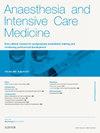先兆子痫-麻醉的考虑
IF 0.3
Q4 ANESTHESIOLOGY
引用次数: 0
摘要
先兆子痫是一种与终末器官损害相关的多系统疾病,是妊娠高血压疾病的一部分。它发生在妊娠20周后,并有助于显著的孕产妇和胎儿发病率。在英国,在最近的孕产妇死亡保密报告中,近2.5%的孕产妇死亡是由它造成的。基于胎盘生长因子的检测和估计可溶性纤维样酪氨酸激酶1与胎盘生长因子(sFlt-1/PIGF)的比值可以提高诊断的准确性和预测产妇并发症的风险。阿司匹林75-150毫克用于产前预防,使用降压药有针对性地控制血压,限制液体,硫酸镁用于预防癫痫发作和及时分娩仍然是降低孕产妇发病率的关键策略。麻醉师可以作为多学科团队的一部分参与管理高血压和严重子痫前期产科急诊,促进复苏,监测和稳定,并提供适当的分娩镇痛和麻醉。如果凝血状态正常,则首选轴突麻醉。如果进行全身麻醉,麻醉师应该认识到先兆子痫的突发性。这应包括准备潜在的插管困难,计划降低喉镜下的升压反应,避免麻醉后出现高血压。重症监护输入可能对有心肺、神经和肝肾疾病的妇女有用。本文章由计算机程序翻译,如有差异,请以英文原文为准。
Pre-eclampsia – anaesthetic considerations
Pre-eclampsia is a multisystem disorder associated with end-organ damage that forms part of the spectrum of hypertensive disorders of pregnancy. It occurs after 20 weeks’ gestation and contributes to significant maternal and fetal morbidity. In the UK, it was responsible for nearly 2.5% of maternal deaths in the recent maternal confidential death report. Placental growth factor-based testing and estimation of soluble fms-like tyrosine kinase 1 to placental growth factor (sFlt-1/PIGF) ratio can improve diagnostic accuracy and predict the risk of maternal complications. Aspirin in the dose of 75–150 mg for antenatal prophylaxis, targeted blood pressure control using anti-hypertensive medications, fluid restriction, magnesium sulphate for seizure prophylaxis and timely delivery remain the key strategies to decrease maternal morbidity. Anaesthetists may be involved as part of multidisciplinary team in managing hypertensive and obstetric emergencies in severe pre-eclampsia, facilitate resuscitation, monitoring and stabilization, and provision of appropriate labour analgesia and anaesthesia. Neuraxial anaesthesia provided the coagulation status is normal is preferred for operative interventions. If a general anaesthesia is administered, anaesthetists should be cognisant of the precipitant nature of pre-eclampsia. This should include preparation for a potential difficult intubation, plans to obtund the pressor response to laryngoscopy and avoidance of hypertension on emergence from anaesthesia. Critical care input may be useful in women with cardio-respiratory, neurological, and hepato-renal morbidity.
求助全文
通过发布文献求助,成功后即可免费获取论文全文。
去求助
来源期刊

Anaesthesia and Intensive Care Medicine
ANESTHESIOLOGY-
CiteScore
0.50
自引率
0.00%
发文量
152
期刊介绍:
Anaesthesia and Intensive Care Medicine, an invaluable source of up-to-date information, with the curriculum of both the Primary and Final FRCA examinations covered over a three-year cycle. Published monthly this ever-updating text book will be an invaluable source for both trainee and experienced anaesthetists. The enthusiastic editorial board, under the guidance of two eminent and experienced series editors, ensures Anaesthesia and Intensive Care Medicine covers all the key topics in a comprehensive and authoritative manner. Articles now include learning objectives and eash issue features MCQs, facilitating self-directed learning and enabling readers at all levels to test their knowledge. Each issue is divided between basic scientific and clinical sections. The basic science articles include anatomy, physiology, pharmacology, physics and clinical measurement, while the clinical sections cover anaesthetic agents and techniques, assessment and perioperative management. Further sections cover audit, trials, statistics, ethical and legal medicine, and the management of acute and chronic pain.
 求助内容:
求助内容: 应助结果提醒方式:
应助结果提醒方式:


